| Columns Retired Columns & Blogs |
May be JVS could do a comparison follow-up review with the Kalista DreamPlay CD player ($43,000) :-) .........
For logistical reasons, I tested a different sample of the Gryphon Ethos (serial number 0110009) from the one that JVS auditioned but was assured that the two samples came from the same production batch. I performed the testing with my Audio Precision SYS2722 system (see the January 2008 "As We See It") using its AES/EBU and S/PDIF digital outputs, test tones on CD, and USB data sourced from my MacBook Pro running on battery power, with Pure Music 3.0 playing WAV and AIFF test-tone files. All the testing was performed with the player's upsampling turned off. Before I played test CDs, I leveled the Gryphon's chassis with its three feet; a bubble level is provided for this purpose.
The player's error correction was good—no glitches were audible in the player's output until the single gaps in the data spiral on the Pierre Verany Digital Test CD reached 1.5mm in length. (The "Red Book" Compact Disc standard requires only that a player cope with gaps of up to 0.2mm.) The AES/EBU and S/PDIF inputs locked to datastreams with sample rates up to 192kHz, the USB input would handle 32-bit data sampled up to 384kHz. Apple's USB Prober utility identified the player as "Ethos USB" from "Gryphon Audio Designs ApS," with the serial number "413-001." The Gryphon's USB port operated in the optimal isochronous asynchronous mode.
The maximum output level from the unbalanced output was 2.16V, slightly higher than the CD standard's 2V. As usual, the maximum balanced output level was exactly twice the unbalanced, at 4.32V. Both outputs preserved absolute polarity (ie, were noninverting) with the remote control's Invert button set to Off. Though higher than specified, the unbalanced output impedance was still a very low 30 ohms across the audioband; the balanced impedance was a low 59 ohms, again at all audio frequencies.
The Gryphon's impulse response varied considerably according to which of the seven reconstruction filters had been selected. With Filter 1, described in the manual as "slow roll-off, minimum-phase," the impulse response was a short minimum-phase type (fig.1). Filter 2, described as "slow roll-off, linear-phase," had an extremely short linear-phase response (fig.2). Filters 3, 5, and 7 all had similar long, linear-phase impulse responses (fig.3), with ringing present either side of the peak. Jason's preferred filter, the hybrid Filter 4, has a small amount of ringing before the peak, with more ringing following it (fig.4). This response is very similar to that of the Hybrid filter offered by the Pro-Ject Pre-Box-S2 (footnote 1). Filter 6 was a long minimum-phase type (fig.5).
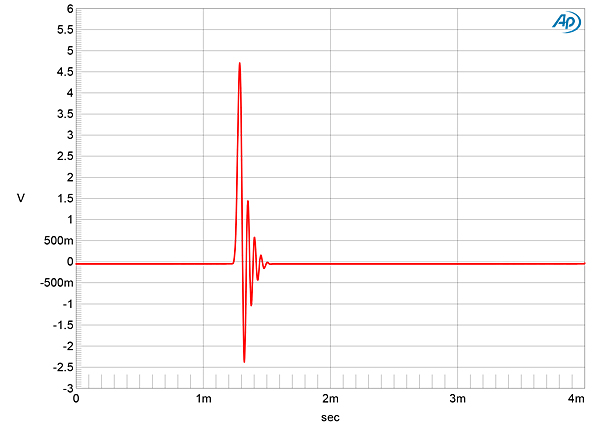
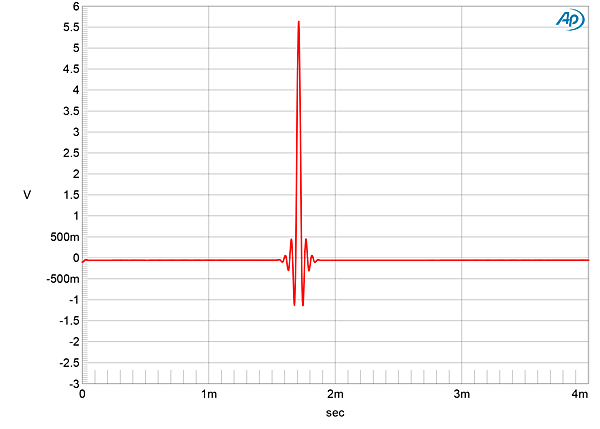
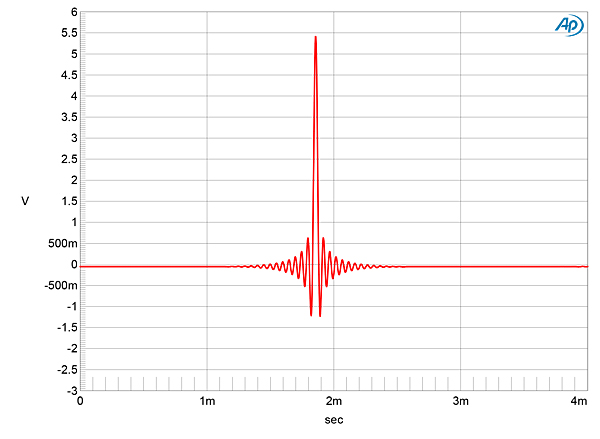
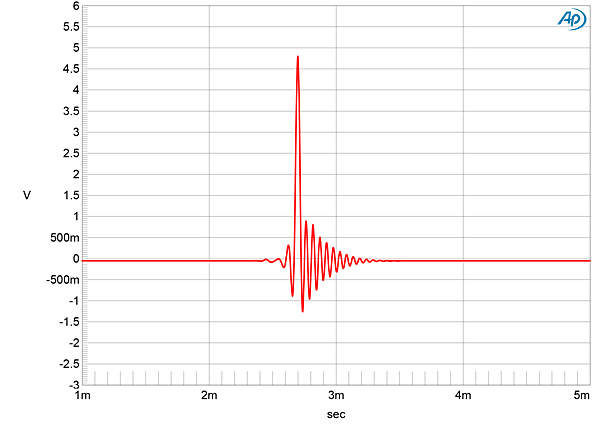
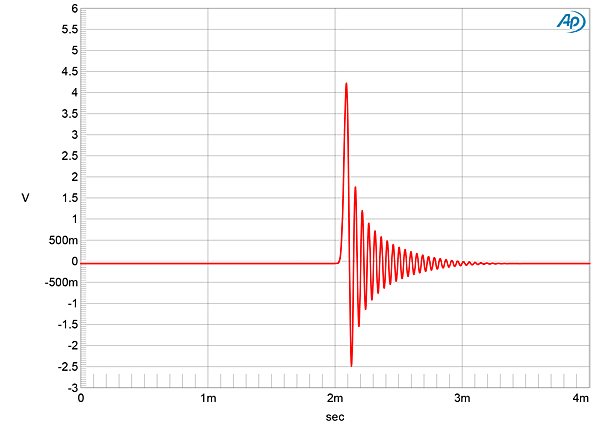
Reconstruction filters with different impulse responses can behave similarly in the frequency domain. Tested with white noise sampled at 44.1kHz, the Gryphon's output with the minimum-phase Filter 1 (fig.6, red and magenta traces) was almost identical to that of the linear-phase Filter 2. Both began to roll off in the top audio octaves and exhibited a slow decline in output at ultrasonic frequencies, the aliased image at 25kHz of a full-scale 19.1kHz tone (blue and cyan traces) suppressed by around 25dB. With Filter 5, described as an "apodizing" filter, the output rolled off very quickly above 20kHz (fig.7, red and magenta traces), reaching the noise floor at the Nyquist frequency of 22.05kHz, this indicated by the vertical green line. Filter 3, a "brickwall" type, behaves identically. Filter 4 also reaches full stop-band suppression by the Nyquist frequency (fig.8) but starts rolling off earlier than Filters 3 and 5. Filters 6 and 7 have identical ultrasonic rolloffs but reach the stop-band noise floor around 24kHz (fig.9).
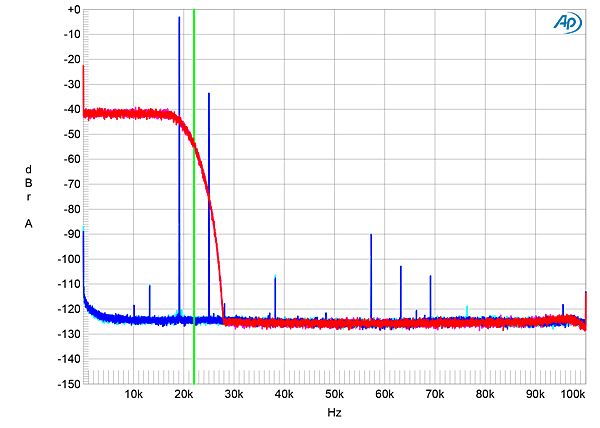
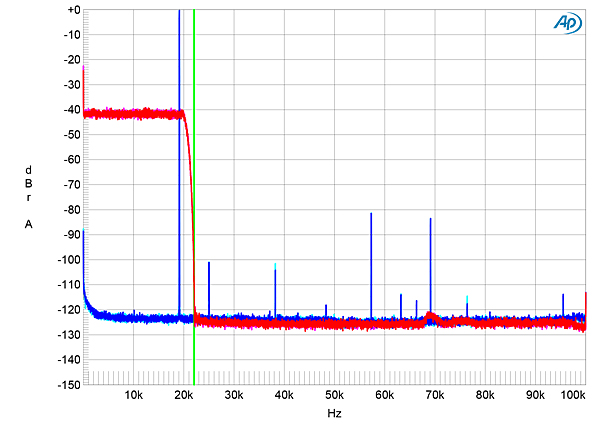
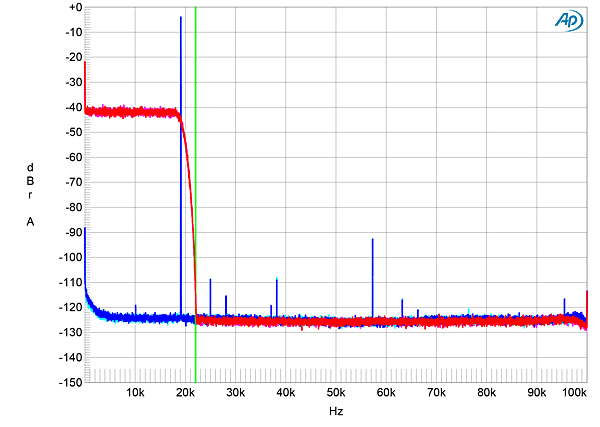
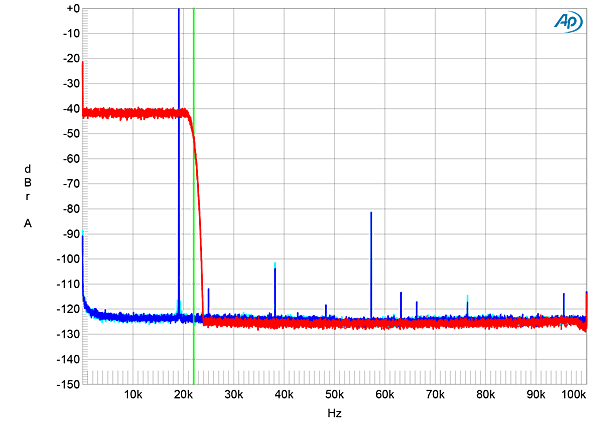
With 44.1kHz data (fig.10), Filter 4 starts to roll off a little above 10kHz but then drops like a stone around 17kHz. It also has some passband ripple, which is generally felt not to be a good thing, as do the frequency responses at 96kHz and 192kHz in this graph. Filters 1–3 have similar audioband responses to Filter 4. Although Filter 5 is flat to 20kHz with CD data, it has more passband ripple than Filter 4. Filters 6 and 7 are textbook fast-rolloff above 20kHz (fig.11). The Gryphon player doesn't apply deemphasis to preemphasized CDs, which results in a boost in the treble reaching 8.5dB at the top of the audioband. Fortunately, preemphasized CDs are very rare these days.
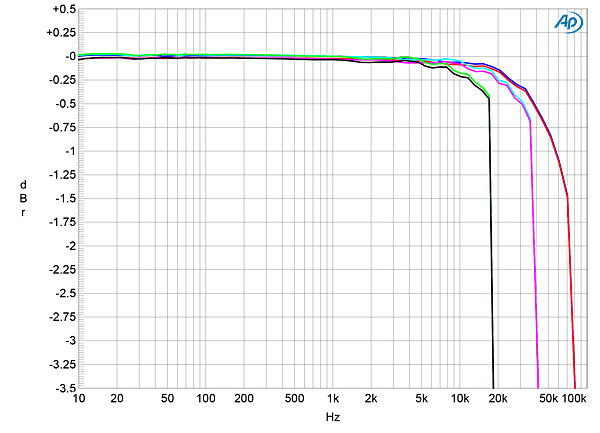
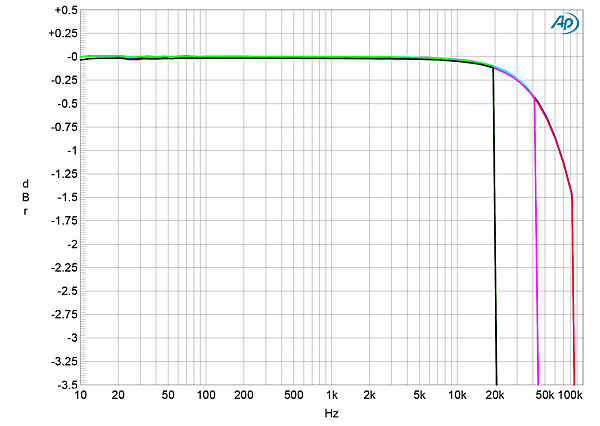
Channel separation (not shown) was superb, at >120dB in both directions below 1kHz, decreasing to a still-superb 103dB at 20kHz. The analog noise floor was extremely low in level (fig.12), and the only power-supply–related artifacts present lie at or below –125dB ref. 0dBFS. Increasing the bit depth from 16 to 24 with a dithered 1kHz tone at –90dBFS sourced from the USB port lowered the noise floor by 23dB (fig.13). Though the low-level supply-related spuriae can still be seen, this reduction in noise suggests the Ethos offers a resolution close to 20 bits, which is excellent. With undithered data representing a 1kHz tone at exactly –90.31dBFS (fig.14), the waveform is symmetrical and the three DC voltage levels described by the data are well defined, with no DC offset present. With 24-bit data at the same level, the Ethos outputs an almost-perfect sinewave, despite the lack of dither (fig.15).
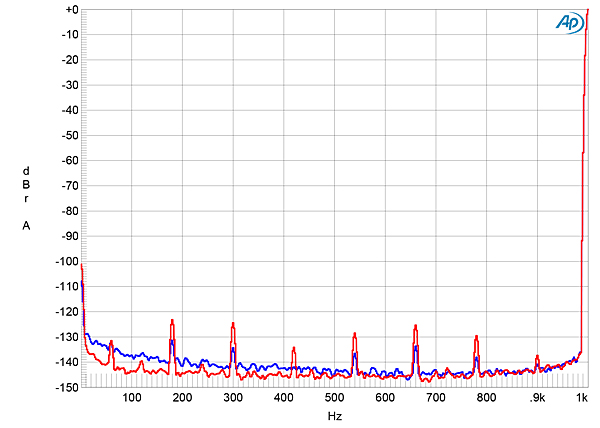
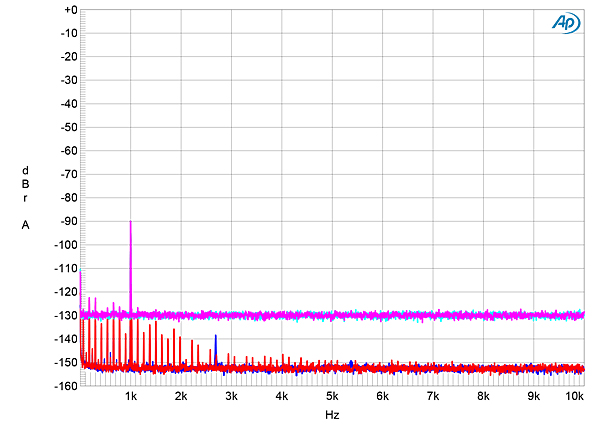
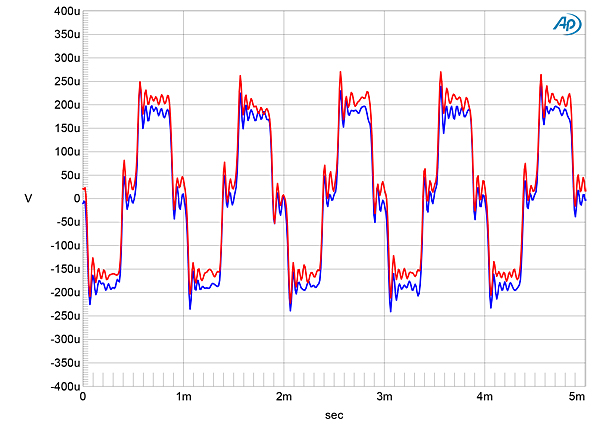
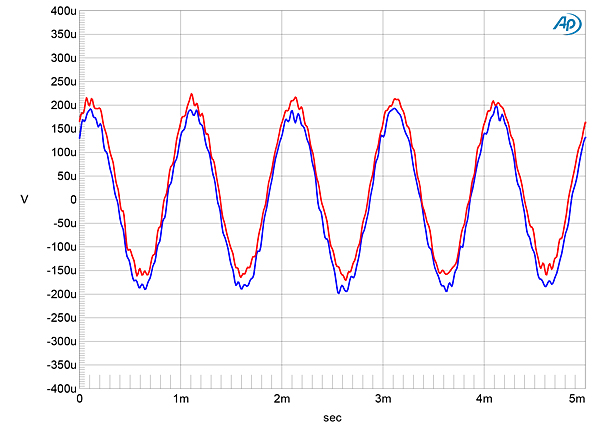
The spectra in figs. 4–6 indicate that the Ethos has low levels of harmonic distortion. With the player driving a full-scale, 24-bit, 50Hz tone into 100k ohms (fig.16), the third harmonic is the highest in level but lies at –80dB (0.01%). The second harmonic is higher in the right channel (red trace) than the left (blue) but is still more than 20dB lower in level. These harmonics didn't increase in level when I reduced the load impedance to a punishing 600 ohms, suggesting that the Ethos has a bombproof output stage. When I tested the Gryphon for intermodulation distortion with an equal mix of 19 and 20kHz tones, actual intermodulation was extremely low, though different amounts of aliased image energy appeared in the audioband depending on which filter was in use. This can be seen with the slow-rolloff Filter 2, for example (fig.17), though the levels of the spuriae are still extremely low. With Jason's preferred Filter 4, there are no aliased images present in the audioband (fig.18).
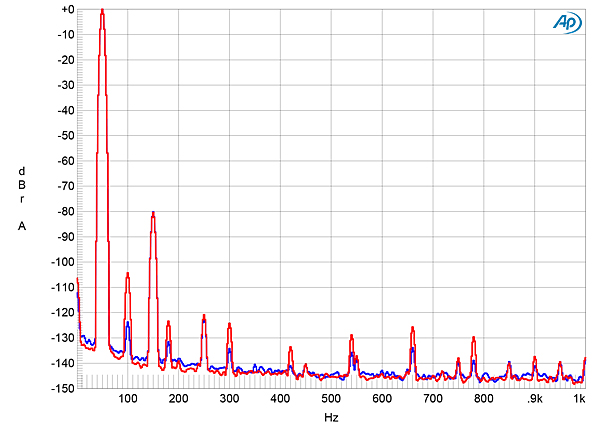
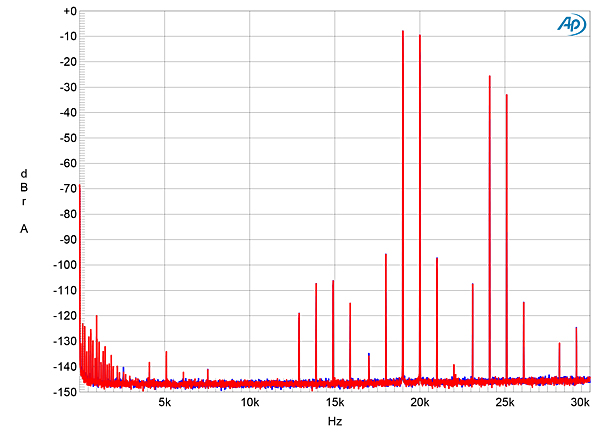
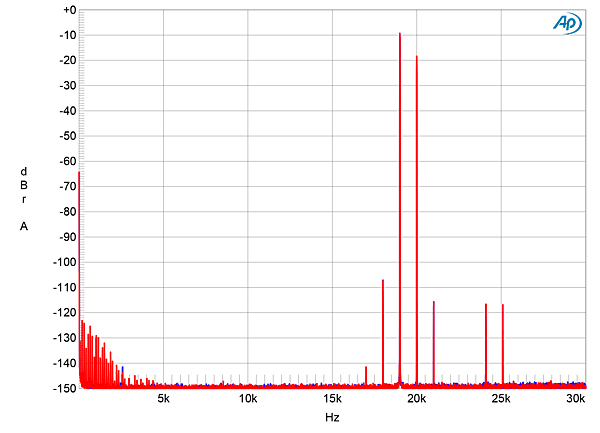
Finally, when I tested the Gryphon Ethos with 16-bit J-Test data (fig.19), all the odd-order harmonics of the LSB- level, low-frequency squarewave lie at the correct levels (sloping green line). No sidebands can be seen. With 24-bit J-Test data (fig.20), the noise floor was low.
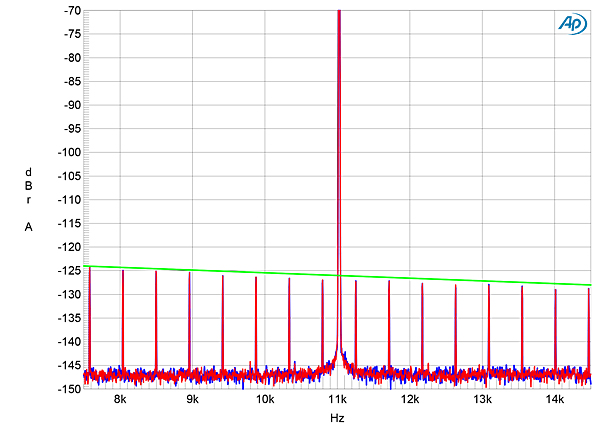
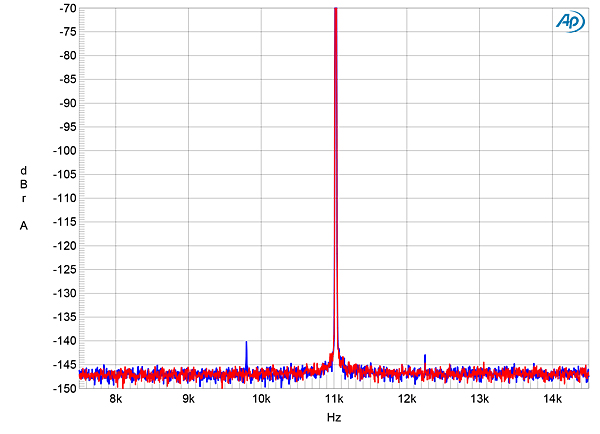
The Gryphon Ethos offers excellent audio engineering, though its sonic character will be dependent on which reconstruction filter is in use.—John Atkinson

May be JVS could do a comparison follow-up review with the Kalista DreamPlay CD player ($43,000) :-) .........

Mirror, mirror on the wall, who's the fairest of them all? :-) .........

So CD player, CD player, which one sounds better ?
Electronic technology advances daily. A state-of-the art designed audio component todate could become a kid's toy soon in the near future.
So to pay big bucks, say $40,000, to acquire a Redbook CD player would be a shaky investment, right ?
Historic paintings, & brandnamed timepieces, like Rolex, for example, appreciate in the market value & are pretty profitable on resale - sound
investment !
Being a die-hard analogue addict enjoying a collection of 1,000+ vinyl LPs (95% classical music), my CD, DVD-audio, Blu-ray discs & streamer are only side-burners. Why? no digital music media todate, IMO, can touch the sound quality of vinyl.
So those affordable digital music lovers, before spending big bucks, like $40,000, to acquire a CD player, why not look out from the 40-year-old Redbook CD box for other better option with more promising music source?
IMO, Blu-ray format is another option, much much more affordable.
Blu-ray HiFi Pure Audio discs are the new digital music star vs SACD.
There are so many Blu-ray music HD (4K) audio/video music programmes now available, e.g. Sony Music, EuroArt, UNESCO, etc.
Look out of the RedBook CD box to find new music source !
For an analogue addict like Yours Truly, my music pleasure surely worths
more than $40,000 yet without financing any exotic hardware vendors.
Listening is believing
Jack L
Canada

Look at it this way ...... Either one of those above mentioned CD players may be a better value than the $50,000 tonearm reviewed in Stereophile :-) .......

Thanks for review, reading your AR M160 review, I remember you liked Progressions without Ref6 pre. Anything has happened in between because you mentioned here that you were using Ref6 with better result. And generally, will you please advice if you prefer direct connection of your dCS stuff to power amp or using a pre. Thanks Jason.

Thanks for review, reading your AR M160 review, I remember you liked Progressions without Ref6 pre. Has anything happened in between because you mentioned here that you were using Ref6 with better result. And generally, will you please advice if you prefer direct connection of your dCS stuff to power amp or using a pre. Thanks Jason.

Hi Ali,
For an answer, please look for my forthcoming review of the D'Agostino Momentum HD preamp. It will help answer your question. As for the ARC Ref 6, it has just been replaced, with an upgrade for existing owners available for $3000.

How about comparing all those pre-amps with Benchmark LA-4 (reviewed by Stereophile) or Benchmark HPA-4 (reviewed by Hi-Fi News)? :-) .........

If JVS likes the 'warm' sound of tubes, may be he could review the new McIntosh C2700 tube pre-amp with built-in DAC and headphone output, $8,000 :-) ........

Jason, it takes some time to find your optimal filter choices but once you find them it is pretty much set and forget. I find the choices helpful.
A nice review.

The review noted:
"Many of our competitors take the current from the output and transform that into an analog voltage," Møller explained. "Instead, we take the voltage directly from the DAC circuitry..."
In fact, most Delta-Sigma dac chips today (including those less than $1 ea.) are voltage out.
-------------
"So Gryphon went with StreamUnlimited of Austria's CD-Pro 8 drive, which only handles CD. "
Interesting ... and very cool that there are still high-quality drives out there. Not sure whether StreamUnlimited is superior to Philips or TEAC.
-------------
For a device THIS $$$, Jason Victor Serinus should have compared to more units (CD players), regardless of price diff. This includes older high-end players from Naim, Boulder, Meridian, etc.

Mr. Hollow, Respectfully, the ESS 9038 PRO DAC chips can be either current output, or voltage output, depending on how they are loaded by the following stage. Interestingly, the ESS 9038 actually produces higher performance when operating in current mode (in terms of DNR), and this is how most manufacturers use these chips. It is unusual for a manufacture to purposefully use the ESS 9038 as a voltage source, so Gryyphon is doing something, perhaps unique, in their implementation of the chips. Although by doing so they are leaving some measured performance on the table; perhaps to gain in some non-measurable parameter based on their listening experience.

The problem with these sorts of expenditures is that they pretty much are disposable items. They become technologically obsolete because of the electronics in a few years.
If you purchased a Patek Philippe watch for the same dollar amount today, there's a really good chance that it would be worth more than what you paid ten or forty years from now, even accounting for inflation.
I can't explain why mechanical devices do better over time than electronics, but they do. Perhaps it's because the individual components go out of production in electronics gear, with very few replacements available over time. If you need a mechanical part, somebody can always machine you a new piece. That's pretty hard with silicon.
I'm not throwing water on a product like this, or critiquing anybody who purchases one. It's just an observation on my part.

...then, what, it's only worth $35,000?

Who in their right mind would spend $39,000 on a CD player? Even if I hit the lottery I would never spend that much

I guess I have no issue with someone offering such a "CD player", but the issue is are there any other players that come near or at the performance of this player for under $5K? Audio bling does not bother me any more the Michael Fremer owning a Caliburn turntable that I can't even afford to dream about. Do his reviews of LPs have any real-world information to pass along to me, one who has refurbished a Dual 502 and put a Rega arm on it?
I am sure that any LP Mr. Fremer would play would be totally revealed to be great or awful. I cannot make those value judgements on the gear I own. It would not be fair, as it would not be fair to judge music playback on such pedestrian equipment I own and use.
So the only real question is does this player have any flaw, because at that price I would think it must not. It is no surprise that DCS gear is so highly praised as cost is no object should win the day. When something is more that any of my first 3 houses in cost, I must pause and ask the question; Where is this hobby going? Can a Tesla be just "another" car?
I can readily see that this is a remarkably great looking player, but it is no wonder why people make fun of audiophiles. There have been CD players reviewed in Stereophile in the $5K to $10K range that have not survived the scrutiny of JA1 when put on the bench. I am glad that this one seems to have passed the test as I feel the owners who anted up a tidy some do deserve not just to have audiophile "bling", but also a truly state of the art player.
I will take some hits for saying this. And, maybe a big part of the cost of this player is the distribution of the R&D that went into the design and manufacture of this player based on the quantity of sales. Nothing come for free.

Measured performance better be great! Unless they messed up and could not deliver standard levels of performance which should be uniformly excellent.
I think most audiophiles appreciate that the price difference between this and a $1000 ES9038Pro DAC is not to be found in the sound quality.

... consider the Marantz SA-KI Ruby or the Yamaha CD-S2100.
https://www.us.marantz.com/us/Products/Pages/ProductDetails.aspx?CatId=referenceseries&ProductId=SAKIRuby
https://usa.yamaha.com/products/audio_visual/hifi_components/cd-s2100/index.html

is that the $1500 CD player by Project uses the same transport, and the quality of the transport is never to be overlooked. I'll bet it is one heck of a player. Denon still makes an CD/SACD player in that same price range.
I just bought a slot load player from a reputable MFG for use at school for our concerts and music programs. Now the player won't read some commercial CD or some CD-Rs. Trying to get it serviced under warrant has been a pain for over a month now, as it is under a year old and still boxed up on my recording studio floor. I will pay more attention to transports of players I buy in the future. Warranties and length of do matter.

I just wanted to point out that Roon is not limited to DSD128 playback but will play files up to DSD 512 with equipment that supports it.

The affliction of CONSUMERISM is the same for the very high end as it is for the low-wage American walking out of WalMart once a week with cart full-o-useless landfillables.
Major pubs, like Stereophile and TAS, do not directly compare new products with legacy ones because of what they may find. Indeed, why have R2R dacs and non-oversampling dacs and vinyl and open reel come back? Better sound? Maybe. Boredom with same-ol'-same-ol'. Gettin' close!

First, some of the formats you mention never went away, and are the subjects of our reviews. Secondly, we don't compare new products with some of those you mention because each reviewer would literally have to pay for a warehouse to store all the products that our online critics have decided we "should" have used for comparison. We'd also have to own them or request them on loan, and have enough time and room for all the set-up required. Dear Sony, Could you please send me your CD player gratis so I can show how poorly it stacks up against the player I'm reviewing? I don't think so.
"Because of what they may find" suggests that we're afraid to voice criticism. Q.E.D.

I should've added that when cross-comparisons with legacy products are neglected, it is a disservice to gear manuf. as well. Because the product (or the product niche) never really evolves in time.
That said, John Atkinson's Measurement's section (and his devotion to that section) merits praise.

John Atkinson's Measurement's section (and his devotion to that section) merits praise.
Thank you. I do wonder at times how widely these measurements sections are read, but I consider them very important, given how few other magazines/webzines publish measurements.
John Atkinson
Technical Editor, Stereophile

I read them 'religiously', more than any religious books, I have ever read ....... Thank you JA1, you definetly deserve 'Knighthood' by the Queen :-) .........

Very cool design - but the fact that it cannot play SACD means that the entire design places form above function, which really doesn't make sense at this price point. You could get away with it on a budget product designed to look nice - but designing a so-called premium product that cannot even play hi-res SACDs sadly means this is dead on arrival, other than perhaps as a photoshoot for coffee table books.

Why build a device that will also play SACD? SACDs cost too much, everybody just buys CD, so this manufacturer is keeping the expenditure and price to the consumer more realistic by sticking to CD. Adding SACD would probably make it a 42,000 dollar proposition, and that would be ridiculous.
(Please note, I posted in 'sarcasm font,' no need to quote me any sales or specification data.)

The cost of manufacturing SACD is higher than manufacturing CD. Jared Sacks (Channel Classics), a major proponent of SACD and DSD, now only issues his best-selling artists in SACD because SACDs cost so much to manufacture. He issues the rest in CD format, and offers DSD downloads of those titles on NativeDSD.com.

But those of us who want a copy of Edith Peinemann performing Dvorak's Violin Concerto, have two options; I can purchase a potentially scratchy vinyl copy from ebay for $75.00 or I can buy an SACD copy from Japan for $49.99 which has plenty of those coveted titles we collectors yearn for. Sorry at $35,000 without an option for SACD is a non-starter for most folks. EMM labs still makes them as does Esoteric. Can get great performance from 44.1 these days from setting up a computer system and ripping your CD copy.

... performed by Edith Peinemann not acceptable?
https://www.amazon.com/Dvorak-Violin-Concerto-Serenade-Strings/dp/B000FILNQW

"... and offers DSD downloads of those titles on NativeDSD.com."
Unfortunately, the days of the download are pretty much over - consumers don't want them anymore, the file management issues are too difficult, and the cost prohibitive compared to streaming which has wiped out downloads in the non-physical market. This is a physical player - and it is not competing in that space because it can't play the relevant formats.

This review brought back to mind a chat I had with the owner of a well know hi-fi manufacturer some years ago. He explained to me why he approached the whole reviewing process with trepidation: “A glowing five star review doesn’t add a single sale, but four stars - or any caveats at all really - can kill a product stone dead.”
Therefore despite both the undoubted prestige of being this month’s cover star, and the fact that JVS makes it abundantly clear he thinks the Ethos sounds pretty fabulous, I suspect the manufacturer's focus might be drawn more sharply to the brief somewhat cursory four point comparison the reviewer makes to his own dCS combo - the Brits proving preferable each time. And yes I know they cost $21k more, but I suspect if a potential customer can afford $39k to start with they will likely be able to make this stretch if so desired.
Many moons ago Gryphon withdrew from the American market following a review that criticised their equipment for being too neutral sounding (or at least something to that effect). Obviously there will be no repeat of that this time around. But I do still end up wondering if they will be that much happier with this one despite the overall positive tone. I guess we will find out when they reply in the next issue.

I wonder what rationale The Grypon used for nomenclature. "Ethos"?
They read the wiki:
Ethos (/ˈiːθɒs/ or US: /ˈiːθoʊs/) is a Greek word meaning "character" that is used to describe the guiding beliefs or ideals that characterize a community, nation, or ideology. The Greeks also used this word to refer to the power of music to influence emotions, behaviors, and even morals.

I didn't know 'power of music to influence emotions, behaviors and even morals' costs, $40K :-) ........

... Goldring is called the Ethos.
Their stated intent for choosing that name is to reflect the character of the company - hence definition number one.
https://www.goldring.co.uk/goldring-ethos.html


Well, once you get the nomenclature outta the way ("Ethos"), other Greek trends begin to reflect in the echo chamber. Anyone see similarities ...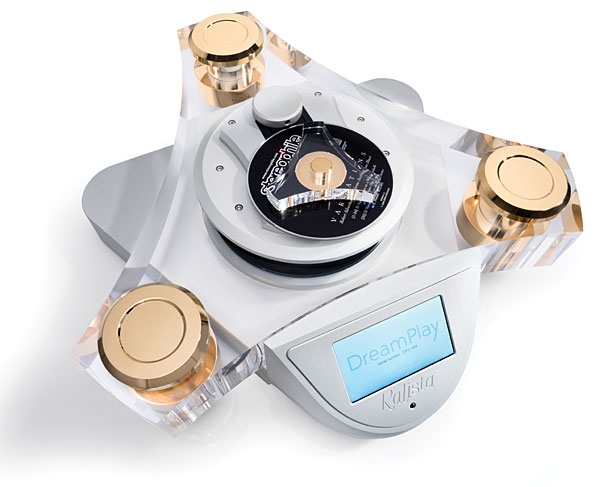


Similarities? ....... Yeah ..... They both are very expensive and, they both look like UFOs :-) .........

..."Viewmaster" capabilities.

Ethos responds to voice commands ......... Just say 'open sesame', and the lid opens ....... Then load a disc and say 'close sesame', and the lid closes :-) .......

Instead of spending $40k on a CD player, one can buy any of the various servers available on the market and, transfer terabytes of CD data .......... Comfortably sit on the listening chair, and listen to music for hours :-) ......

It is simply a fact that wealthy hobbyists encourage manufacturers to push the envelope. New technologies then trickle down to benefit all hifi enthusiasts. It baffles me why some in the community cannot see the huge merit of this. And it is up to the discerning consumer to decide if he wants to buy into new technologies or not. This is a hobby after all, which keeps a lot of brilliant artisans and superb craftsmen usefully and peacefully employed, provides a income to artists and keeps us, listeners, very happy.
But I would like to comment on the physical media and my own experience with them. I do hope that manufacturers and producers read the comments posted on Stereophile. They might provide them with food for thought.
I am in the blessed position to own both a top-end vinyl replay system consisting of a Clearaudio Master Innovation with Statement parallel arm and Ortofon Century, and a 3-piece suite of dCS Vivaldi Transport, DAC and Clock. Amplification Burmester, loudspeakers Audio Exclusiv (full electrostatics). With a great deal of attention given to power supply, cabling and equipment support. With other words, a dream system built over many years and optimized to enjoy the sound reproduction of “non-electronic” instruments (classical, jazz, voice). 80% of my listening is classical. I don’t “do” streaming.
Being completely unbiased, and heavily invested in CD, SACD and vinyl with some of the best equipment to play them on, I can postulate today with confidence that SACD, when well recorded, is the King of Formats. And this notwithstanding the fact that I am obsessed with vinyl. But when I compare the same piece issued both on SACD and vinyl (Channel Records, Pentatone), SACD carries the day by a whisker: a touch airier, a slightly truer tone and yes, an even better “flow” that facilitate following the musical argument. On the other hand, vinyl’s sound stage remains unbeaten, as the ClearAudio parallel arm recreates a truly “cavernous” sound world. And although both media allow unrestricted (subjective) dynamics, SACD is simply a fraction quieter. CD is a VERY distant third (notwithstanding the dCS wizardry to bring it to life).
I find it therefore incomprehensible why Universal Music Group, which owns a.o. DG, Decca and EMI robs its artists of the opportunity to record on SACD. UMG even makes a mess of pressing vinyl. Listen for instance to the popping, cracking, rumbling (!) DG vinyls of Abbado’s Bruckner 9th, his last and deeply moving recording – with the superb Zimerman in Schubert D959 & 960 barely better. I therefore bade farewell to my roster of UMG artists and, when buying digital, I now exclusively buy SACDs. From labels like Ars, BIS, Challenge Records, Channel Records, Pentatone, RCO Live etc. And guess what: I discovered stellar performances by stellar new artists (or who migrated away from UMG), superbly recorded - by which I mean: “uncannily close to Live”. I wish opinion-makers at Stereophile would walk that extra mile in favour of SACD.
I would therefore also caution lovers of classical music and jazz when they audition the Gryphon Ethos. They should compare it with a good SACD player. SACD as a format is so much more enjoyable to listen to than CD, especially in the above genres. Is CD therefore a basket case? Probably. Although a small Dutch label, TRPTK, produces beautifully recorded CDs. Maybe it is on to something. Whilst vinyl remains vinyl: superbly tolerant of mediocre recording, poor power supply, shoddy bases, with the hardware delivering excellent performance even at humblest price points (Dual!). Supremely affordable, lots of fun, and endearing. My 40-year old records still outclass anything on CD sound-wise, the 2nd hand market is awash with great performances sumptuously recorded with mint copies going for under 10 euros, new productions avoid the pitfalls of CD – even in jazz, with new work on the Newvelle label or by the venerable, magical Charles Lloyd.